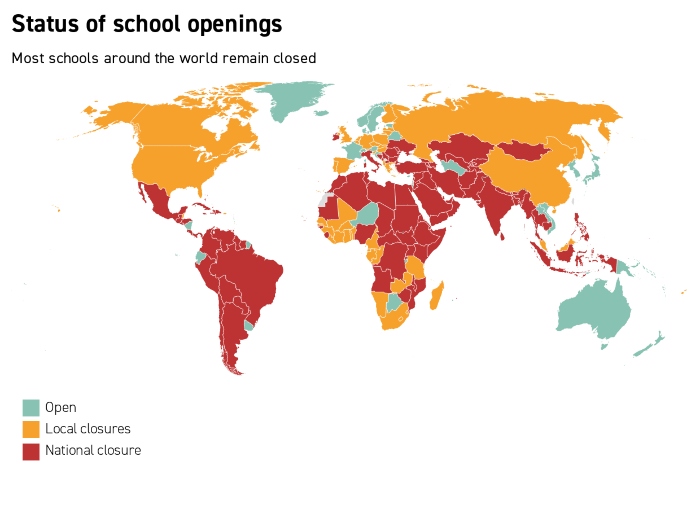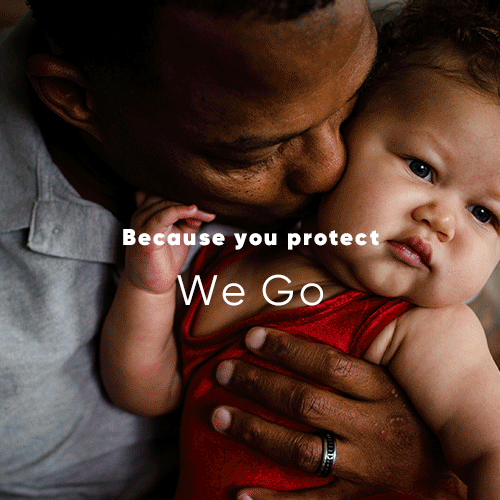
BY RYAN HEATH AND MYAH WARD
|
GEOGRAPHY LESSON — If you think the U.S. is a Covid-19 outlier when it comes to keeping schools closed, think again. While the CDC is now pushing hard for school reopening, the reality is most schools in most countries are still closed. That leaves more than a billion students locked out of the classroom, as governments work toward state or national control of the virus before reopening.

Map: Ryan Heath / POLITICO Source: UNESCO
President Donald Trump is right that children face a lower risk of contracting the novel coronavirus, and Mark Woolhouse, an epidemiologist member of the British government’s pandemic advisory committee, says there is no recorded case worldwide of a teacher catching the coronavirus from a pupil.
But the administration is missing key context when it points to European countries with open schools as a model to follow,
A combination of three factors exist in Europe, New Zealand, Australia and other countries, which enabled them to re-open their schools.
1. The virus is under control because of widely adhered nationwide pandemic rules. We’re talking daily deaths in the single digits.
2. They have functional safety nets of universal health care and public schools with enough funds to adapt to hybrid learning or other teaching models.
3. Teachers unions have typically been involved in planning from the get-go. That’s essential, because teachers are the only viable enforcers of new safety rules.
Everywhere else is missing at least one of these ingredients, and in the U.S. all three ingredients are missing in most states and at the federal level.
Even if Congress this week or next approved the $116.5 billion, or even some portion of it, that the American Federation of Teachers wants for safety upgrades, it would take weeks and probably months to deliver the boost.
Whatever the plan, it takes time to get back into the classroom. The World Health Organization has a 54-point checklist. South Korea delayed its reopening five times.
Most successful countries staggered reopening, starting with the youngest children first. Even so, in Germany, where at least some classes are operating in every state, as many as 30 percent of teachers are ill, isolating, at-risk or unwilling to teach.
Israel messed up badly: Its schools reopened in May, not with the under-9s as originally planned, but with all ages together. When a heat wave swelled temperatures to more than 100 degrees F, mask requirements were dropped. Outbreaks followed quickly, causing a new shutdown. The country’s top health official resigned, claiming his advice had been ignored.
Sign up for Global Translations, Ryan’s POLITICO newsletter on essential global news, trends and decisions.
Welcome to POLITICO Nightly: Coronavirus Special Edition. Renu is on the move, but her inbox is still right here. Reach out rrayasam@politico.com or on Twitter at @renurayasam.
A message from Emergent BioSolutions:
Our global team is going full speed to develop potential therapies that may help treat COVID-19. At the same time, we’re collaborating on innovative vaccine candidates that can be made by the millions. Discover what we’re doing right now.
| FIRST IN NIGHTLY |
SUBURBAN WARFARE — Trump says Joe Biden wants to abolish the suburbs. But polls show a different truth: The suburbs want to abolish Donald Trump. If current numbers hold, the Republican Party will suffer its worst defeat in the suburbs in decades — with implications reaching far beyond November, national political correspondent David Siders writes.
It was in the suburbs two years ago that Democrats built their House majority, ripping through Republican-held territory across the country, from Minnesota and Texas to Georgia, Virginia and Illinois. It would be bad enough for the GOP if that had been a temporary setback. But with the prospect of a second straight collapse in the suburbs this year, it is beginning to look like a wholesale retreat.
“We can’t give up more ground in the suburbs nationally without having a real problem for our party,” said Charles Hellwig, a former chairman of the Republican Party in Wake County, N.C., describing a landscape in which “every year, every month, every day, we get a little bluer.”
LIVE: OREGON ATTORNEY GENERAL ELLEN ROSENBLUM JOINS TO DISCUSS ONGOING PROTESTS – 7/27 @ 2:30 p.m. EDT: Join Playbook authors Anna Palmer and Jake Sherman for an interview with AG Rosenblum, who filed a lawsuit against the Trump administration alleging that federal agents are arresting protesters in Portland without probable cause, taking them in unmarked cars and using excessive force. REGISTER HERE.
| AROUND THE NATION |
WHEN SEPTEMBER ENDS — Congress and the Trump administration gave roughly 40 million Americans a coronavirus reprieve in on their federal student loans. In March, all monthly payments were suspended. Interest rates were set to 0 percent. And the Education Department was essentially ordered to stop pursuing defaulted loans. All of those protections, which were included as part of the CARES Act, are set to expire at the end of September. Nightly’s Myah Ward talked to education reporter Michael Stratford about the discussions on the Hill to extend the relief and what Sept. 30 could mean for millions of Americans. This conversation has been edited.
Debates are happening around the next stimulus bill. Has this been part of the discussion?
Yes, to some extent. But it’s largely flown under the radar.
Where do the two parties stand?
Democrats have been most vocal about wanting to extend the student loan relief — and many want to go even further and provide loan forgiveness of up to $10,000 per borrower. That type of outright debt cancellation isn’t palatable to Republicans at all. But it’s been harder to gauge where GOP lawmakers stand on a simple extension of the existing CARES Act benefits.
If those benefits aren't extended past Sept. 30, what’s the impact?
Student loan borrowers are going to have to resume making monthly payments, and the interest will again begin accruing on their debt. Consumer advocates warn that could send delinquency and default rates soaring, given the economic recession that we’re in. But there’s an important political angle as well: The Education Department would be in the position of demanding payments from tens of millions of Americans in October in the weeks leading up to the November election. It certainly seems like a politically risky move to take away benefits from your constituents just as they’re heading to the polls.
What should people expect to happen next?
As far as we know right now, an extension isn’t included in the Senate GOP plan that’s expected to be released next week. But that could change, especially when negotiations begin in earnest with Democrats, who’ve demanded that an extension be included in the next stimulus bill.
A message from Emergent BioSolutions:
| PUNCHLINES |
‘IT’S CALLED A FACE MASK’ — Matt Wuerker takes us through the week that was in political satire and cartoons in the latest Punchlines, covering federal officials cracking down on protests in U.S. cities, the president’s cognitive test results, the ongoing coronavirus pandemic and much more.
| ASK THE AUDIENCE |
Nightly asked you: Have you gotten tested for Covid-19? Do you want to get tested but are unable to? Tell us your testing experience. Below are some of your lightly edited responses.
“It was really easy. In Illinois, they have a number of drive up test centers. Got there at 1 p.m., was out by 1:30. Results in 48 hours. No charge. This is my third test, and the key is that Illinois-run centers do not use commercial labs. IDPH and University of Illinois have built out their testing capacity.” — Mitchell Weiss, IT director, Buffalo Grove, Ill.
“My insurance requires three symptoms, including cough and fever. I had a symptom of extreme fatigue, sleeping much more than usual and not feeling well (the same symptoms my cousin had before testing positive a few weeks ago). The Los Angeles area no longer offers government sponsored testing without regard to symptoms.” — Rachel Thomas, teacher, Hermosa Beach, Calif.
“I am a psychologist consulting to rehabs and nursing homes. I’ve been tested three times: The first two were just to ensure my status as a health care practitioner. The last and most recent was because I had been feeling bit weak and fatigued, mildly confused and achy. My first test was the deep swab conducted by the National Guard (negative). The second was a self-administered nasal swab at a local CVS (negative results online in about a week). The third and most recent was ordered by my primary care provider because of my mild symptoms, and the results are still pending over a week later. Certainly seems that with the surge in cases in the South & Southwest the testing system is overloaded.” — Donald Lester Round, psychologist, Cranston, R.I.
“I got tested at Starboard Restaurant and Bar in Dewey Beach, Del., as part of one of the community testing events in late June. My roommate and I only had to wait 20 minutes or so for the test. Because we did the saliva test, it was totally painless. My roommate got her results the next day. I didn’t get mine for 6 days and only because I tried to track them down myself. When I asked why I hadn’t received them, they just said the labs were overwhelmed by the sheer volume of tests. It provided an interesting glimpse into the testing debacle in the U.S. — no wonder we can’t snuff out the virus if people could be walking around for a week before they get their results!”
— KELLY ANDERSON, GOVERNMENT AFFAIRS, ALEXANDRIA, VA.
|
“There is only one test site in my county, and it is not easily accessible. Currently a triage nurse ensures you qualify to be tested since their capacity is low. The same site is home to a major behavioral health group that processes evaluations for the local municipal court and the jail in addition to seeing diverse clients.” — Stephen Michael Kellat, writer, Ashtabula, Ohio
“In our area, there is much confusion about who deserves a test. We have done very well in fighting the virus. Other than the local hospital, which tests all people who are inpatients, there is the CVS testing site. You have to register online and answer general questions about your health. I am 78 years of age, have asthma and would like to get a test. I completed the form and the digital answer is, ‘No, you are not eligible for a test.’ Yet we keep hearing anyone who wants a test can have one." — Theresa Guertin, retired, Putnam, Ct.
“At the time, it was very easy to be tested in the Denver metro area. I was covering the systemic racism protests in Denver for ABC News and followed the advice of Gov. Jared Polis and got tested. I signed up in the morning, drove to the Pepsi Center parking lot and was tested in about 90 seconds. Results in three days. Negative! That’s not the case now, though, as one of our adult sons waited for hours to be tested and got his results in a week. A big change from several weeks ago.” — Carl Filoreto, photojournalist, Arvada, Colo.
BECOME A CHINA WATCHER : The U.S. is talking about China in a way it hasn't since the days of Mao Zedong's rule. While experts say there is a "zero percent" chance of a decoupling between the two world powers, the era of seamless globalization is over. Join the conversation and gain expert insight from informed and influential voices in government, business, law, tech, and academia. China Watcher is as much of a platform as it is a newsletter. Subscribe today.
| NIGHTLY NUMBER |
$580,000
The amount of money two California Central Valley cities could lose in coronavirus relief due to resolutions each passed in May declaring that all businesses would remain open in defiance of state public health orders. In letters addressed to the city managers of Atwater and Coalinga on Thursday, the California Governor's Office of Emergency Services warned the jurisdictions they would not receive their portion of designated federal relief funds until they’ve rescinded the resolutions and implemented state guidelines.
|
| PARTING WORDS |
NORDIC TRACKER — This week, officials at the Swedish Public Health Agency, which devised the country’s no-lockdown strategy, claimed the rate of coronavirus immunity in Stockholm could be as high as 40 percent and is already playing a big role in pushing back the disease, Charlie Duxbury writes.
“We are clearly at levels which are very significant,” lead epidemiologist Anders Tegnell told reporters at a news briefing on Tuesday. “The reduction we are now seeing speaks strongly in favor of a very large immunity in the population.”
It appeared to be a rare piece of good news in a country that has seen a stubbornly high infection rate and inevitably raised hopes that so-called herd immunity — where an immune group protects a still-susceptible group from disease — could be near. Previous estimates have suggested herd immunity rates when it comes to coronavirus could be around 45 to 50 percent of the population.
However, critics were quick to challenge the Public Health Agency’s statements. Twenty-five Swedish doctors and scientists published an open letter attacking the government’s approach to tackling the virus and claiming immunity rates were well below those mentioned by the agency, and possibly as low as 10 percent.
A message from Emergent BioSolutions:
We go after public health threats. In the fight against COVID-19, we are going full speed to develop potential new therapies and vaccine candidates.
We go for critical innovations. We are developing two potential hyperimmune treatments for severe hospitalized COVID-19 patients and individuals at risk. Based on proven technology, the research and testing are underway.
We go in partnership with others. We are working with industry innovators to bring COVID-19 vaccine candidates to market. We have the capacity to manufacture vaccines in the tens to hundreds of millions, and we are propelling development forward.
We go. And go. From fighting anthrax to helping prevent smallpox and developing vaccine candidates, we go all in. Because public health threats will never stop. And neither will we.
See how we go all in.
We go for critical innovations. We are developing two potential hyperimmune treatments for severe hospitalized COVID-19 patients and individuals at risk. Based on proven technology, the research and testing are underway.
We go in partnership with others. We are working with industry innovators to bring COVID-19 vaccine candidates to market. We have the capacity to manufacture vaccines in the tens to hundreds of millions, and we are propelling development forward.
We go. And go. From fighting anthrax to helping prevent smallpox and developing vaccine candidates, we go all in. Because public health threats will never stop. And neither will we.
See how we go all in.
Did someone forward this email to you? Sign up here.
Follow us on Twitter
Renuka Rayasam @renurayasam
|
|




No comments:
Post a Comment
Note: Only a member of this blog may post a comment.